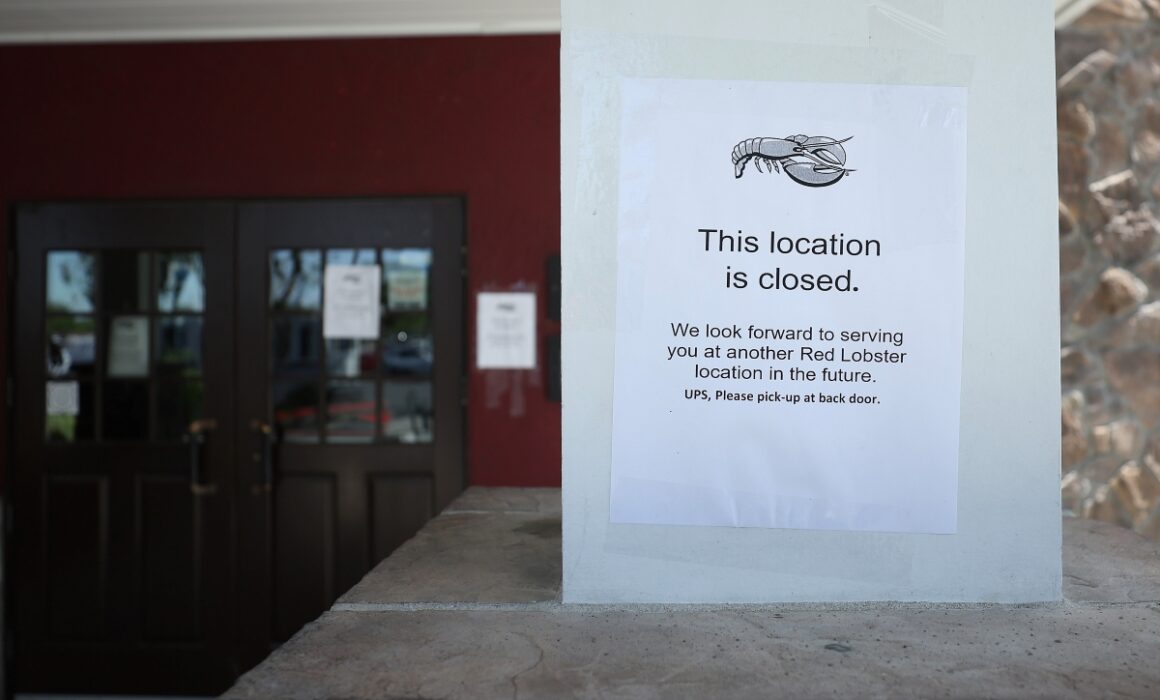Lobster Tales: How Red Lobster Sank Like a Boat Full of Butter
May 30, 2024
By Emily DiVito, Eizabeth Pancotti
Fireside Stacks is a weekly newsletter from Roosevelt Forward about progressive politics, policy, and economics. We write on the latest with an eye toward the long game. We’re focused on building a new economy that centers economic security, shared prosperity, and rebalanced power.
(Photo by Justin Sullivan/Getty Images)
Earlier this month, mega restaurant chain Red Lobster filed for bankruptcy. We’re mourning the loss of the cheddar bay biscuits and Crabfest™. Since news of the bankruptcy filing broke, there have been countless jokes that Red Lobster’s “ultimate endless shrimp” (UES—yes, that’s an official legal acronym) was its undoing. To be sure, giving people as much shrimp as they could possibly eat for just $20—and then $22 and then $25—lost the company money. However, the promotion was just the tail end of their troubles. Red Lobster’s corporate overlords have a long history of extractive capitalism.
*in the voice of SNL’s Stefon* Florida’s hottest new bankruptcy filing has it all: discounted bottomless seafood, fishy supplier contracts with its own major shareholder, sale leasebacks, rock-bottom wages, and anti-worker behaviors.
In May 2023, former CEO Paul Kenny (our hero), made the decision to make $20 all-you-can-eat shrimp a permanent experience at Red Lobster—perhaps a shortsighted decision, given the company’s history of underestimating just how much seafood people will eat. In 2003, Red Lobster ran a $23 ($41 in today’s dollars) endless crab promotion that lost the company $3.3 million in just seven weeks, wiping out $400 million in then-parent company Darden Restaurants’ share value in a single day. “It wasn’t the second helping on all-you-can-eat, but the third” that hurt profits, according to the then-chairman’s remarks to Wall Street analysts. The then-COO added: “And maybe the fourth.” Twenty years later, diners put down 23 rounds of shrimp scampi and 30 orders of fried shrimp. Though the chain ultimately increased the price of the promotion to $25, shrimp-gate resulted in $11 million in losses.
But it wasn’t botched shrimp-casting that did in the restaurant chain.
Red Lobster was founded in Florida in 1968 by Bill Darden, who would later create Darden Restaurants, which currently operates giant chains The Capital Grille, Olive Garden, and LongHorn Steakhouse. What started as an affordable family-friendly restaurant quickly got co-opted by corporate interests. In 1970, Red Lobster, then still a small chain of just five locations, was sold to food monopolist General Mills. General Mills rapidly expanded the chain: By 1985, there were 372 Red Lobsters nationwide. In 1995, General Mills spun off its restaurant dealings into Darden Restaurants.
Darden Restaurants is a notoriously s(h)elfish corporation. Today, the company, which boasts 1,900 restaurants and 190,000 workers, is a big fan of the federal subminimum wage for tipped workers—locked at $2.13 an hour since 1991. Tipped worker advocacy group, One Fair Wage, Inc., has long argued—even suing Darden in 2023—that forcing workers to be at the mercy of customer tips for their pay creates a working environment ripe with sexual and racial harassment.
By 2013, seafood prices—due in part to increasing industry concentration—were rising, and Darden’s banner chains like Red Lobster and Olive Garden were struggling. The company’s activist hedge fund investors were losing faith in management. In 2014, Darden, under pressure from these activist investors, sold Red Lobster to private equity firm Golden Gate Capital for more than $2 billion in cash, after which Darden sat through a whopping (and hilarious) 294-slide PowerPoint from one such investor, Starboard Value, on improving operations at its remaining chains. The deck reveals some gems about the extreme measures Darden had taken to improve its ROI. As just one example, Darden had stopped salting the water at Olive Garden in order to extend the shelf life of its pots and at the expense of food quality.
Once it had acquired Red Lobster, Golden Gate then immediately got to work executing the tried and true private equity playbook: extract as much value as possible from the corporation without regard to workers, customers, or communities.
One common method of this extraction is the sale leaseback, where the private equity firm makes the portfolio company sell the land on which their business sits and lease it back—often at huge markups. Golden Gate ran this play with Red Lobster, selling the chain’s real estate to American Realty Capital Properties, Inc. (ARCP) for $1.5 billion in 2014 and locking each individual restaurant into multiyear (94 percent for 25 years), above-market-rate rental leases, even at struggling locations. In 2023 alone, Red Lobster spent nearly $191 million in lease obligations, including $64 million on underperforming stores—nearly 10 percent of their revenue.
ARCP wasn’t new to the sale leaseback game. By 2014, the year they bought Red Lobster’s real estate, they had already acquired 105 million square feet of property across more than 4,000 merchants at average leases of 12.5 years. According to ARCP’s CEO, “[Stores] don’t need to own the real estate; they can rent it. That’s great for our shareholders.” Executives from ARCP have since been forced to pay tens of millions of dollars in fines and settlements for inflating their financials; one of them went to jail for securities fraud. So, all in all, an excellent cast of characters with which to be doing business.
Just two years after selling off the real estate, Golden Gate began offloading the company itself, as private equity firms are wont to do. In 2016, it sold 25 percent of Red Lobster to Thai Union, the Thailand-based seafood company and canned tuna empire, for $575 million. In 2020, it sold much of the rest of the business to an investor group that Thai Union founded, the Seafood Alliance.
In 2022, Red Lobster reportedly cost Thai Union nearly $35 million in losses, prompting the investor to weigh exiting investment in the chain in early 2023. Thai Union’s CEO said at the time, “Thai Union has never prolonged any bad business.” Just two months after telling Bloomberg they might sell off the company, Red Lobster made the shrimp promotion permanent. As clever an idea as it was, it couldn’t save a company saddled with debt and exorbitant real estate expenses caused by private equity vultures.
In 2023, Red Lobster was forced to pay $27 million in debt and $32 million in interest payments. Within just six months, the chain’s cash-on-hand declined by 60 percent, from $100 million to less than $30 million. For those of you keeping track, that’s nearly three times as much as the failed shrimp promotion lost them. And now that bankruptcy has been filed, its creditors are starting to line up to get their due.
There’s one place, however, where investor extraction and cheap shrimp come together. UES was, perhaps, a scheme manufactured to funnel money back to their primary shareholder, Thai Union. The story would surely make the OG Lobster Mobster proud.
The bankruptcy filing tells the story of shady shellfish, alleging that former CEO Paul Kenny helped manufacture shrimp shortages—by encouraging abnormally aggressive promotion of UES—in ways that enabled Thai Union, which soon became Red Lobster’s exclusive shrimp supplier, to circumvent normal supply chain processes or competitive bidding cycles. Current Red Lobster CEO Jonathan Tibus said the seafood supplier “exercised an outsized influence on the company’s shrimp purchasing.” This, Tibus claims, resulted in higher costs for Red Lobster—creating a novel cash flow straight to the company’s main shareholder that insulated it from the broader financial health of the investment.
While the news of Red Lobster’s bankruptcy this month might have seemed out of the deep blue sea, the company’s arc tells an unfortunately familiar story. With private equity, bankruptcy is the point. The minute that private equity got involved, Red Lobster was put on a path toward extermination, where it would be sold for parts along the way—its 36,000 workers and millions of customers (us! you!) be damned. While most Red Lobster restaurants will remain open during the bankruptcy process, almost 100 stores across the country closed in the wake of the news. And affected workers, who got little more than a day-of layoff notice from the shift scheduling app on their phone, abruptly lost their jobs.
As one person lamented on X: “All we did was force Red Lobster to sell its land to our other companies who rented it back at a markup, force it to purchase marked-up supplies from our other companies, and then have it borrow a ton to pay c-suite bonuses, and boom, it went bankrupt just like that.” Funny how that works.
If You Ask Eleanor
If you’re looking for a new delicacy to replace the cheddar bay biscuit–sized hole in your heart, we (sort of) recommend this recipe from Eleanor:
I have one summer dessert that I like particularly, perhaps because the huckleberries are picked on Campobello Island and have a very special flavor. I think this recipe also is good with substitute berries.
HUCKLEBERRY PUDDING:
Line sides and bottom of glass casserole with slices of white bread (not too fresh) from which crusts have been removed. Pour in stewed huckleberries to cover bottom. Continue adding bread and berries alternately until the dish is filled, with berries on top. Then put in refrigerator for eight to twelve hours. Serve with plain or whipped cream.
– Eleanor Roosevelt, If you ask me (July 1958)




